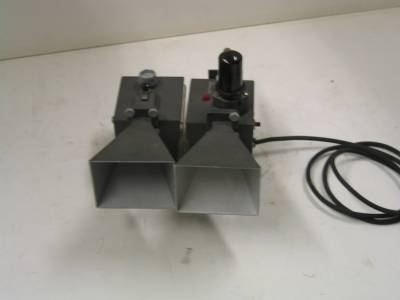Table of Contents
Microwave Polarization
Description
This demonstration consists of a microwave receiver and transmitter pair along with a set of metal plates. The plates have slits of different sizes and orientations cut into them.
Purpose
Demonstrates the absorption or transmission of microwaves as it depends on the polarization of the incident microwaves.
Apparatus
- Microwave receiver
- Microwave transmitter
- Metal plates (four, two with thin slits, one with multiple wide slits, and one with a single wide slit.)
- One-dimensional crystal models to demonstrate Bragg reflection ( Bragg's law)
Setup
Place the receiver and transmitter about 10cm apart, so that they face each other. Plug in the transmitter and turn it on with the 'displacer' knob, then set the gain to the maximum on the receiver. Give it about twenty seconds to warm up, and then adjust the 'displacer' knob on the transmitter until it's producing the maximum response on the receiver. Adjust the gain of the receiver until it's at the desired value.
Now, you can put plates (or other objects) between the pair to observe their transmission of absorption of microwaves.
- When the narrow slits are vertically oriented, most of the microwaves are blocked.
- When the narrow slits are horizontally oriented, most of the microwaves are allowed to pass through.
- When the narrow slits are diagonally oriented, about half of the microwaves get through.
Notes
The receiver only works if the metal tab sticking out from the brown dial is in contact with the metal disk underneath. This probably completes the connection between the receiver and the dial.
Demo room information
| Location | A2 |
| Maker | Unknown |
| Current State | Working |

